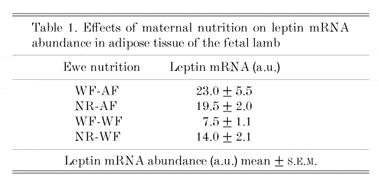Fetal plasma leptin concentrations and mRNA abundance in adipose tissue gradually increase during late gestation to peak near to term (Yuen et al. 1999). Increasing maternal nutrition during late gestation enhances fetal weight, although adipose tissue deposition is reduced (Budge et al. 2000). The extent to which parallel effects on leptin expression occur are not known. The aim of the present study was to examine whether manipulating maternal feed intake during pregnancy programmes leptin mRNA expression in fetal adipose tissue.
Twenty-four singleton-bearing ewes of similar body weight and parity were randomly allocated to one of four feeding groups from 28 days gestation as described by Dandrea et al. (2001). Twelve ewes were provided with 60 % of their total energy requirements for body weight and pregnancy in order to produce a 4.5 kg lamb at term, from 28 to 80 days (i.e. nutrient restricted (NR)) gestation whilst the remainder continued to receive ad libitum feeding and consumed 150 % of requirements. After 80 days gestation, seven of the nutrient-restricted ewes and six control ewes were provided with 150 % of their total energy requirements for body weight and pregnancy until term (i.e. nutrient restricted-well fed (NR-WF), or well fed-well fed (WF-WF) groups, respectively) whilst five nutrient-restricted ewes and six control ewes received 100 % of requirements (i.e. nutrient restricted-adequate diet (NR-A), or well fed-adequate diet (WF-A) groups, respectively). All ewes were killed with an overdose of barbiturate (100 mg kg-1 pentobarbital sodium: Euthatal) between 140 and 145 days gestation (term = 148 days), to enable fetal and perirenal adipose tissue sampling. All animal procedures were performed in accordance with UK legislation. Total RNA was extracted from adipose tissue. Leptin mRNA abundance was examined by RT-PCR, using oligonucleotide primers specific to ovine leptin (forward 5Ì-CACCAAAACCCTCATCAAGACG-3Ì and reverse 5Ì-ACATTTCTGGAAGGCAGACTGG-3Ì). Values are means ± S.E.M. and significant differences were assessed by analysis of variance. Leptin results are expressed in arbitrary units as a ratio of an 18S rRNA internal control.
Lambs born to ewes WF from 80 days gestation were heavier (e.g. WF-A 3.9 ± 0.2 kg; WF-WF 4.8 ± 0.2 kg (P < 0.01)) but possessed less adipose tissue (e.g. WF-A 22.8 ± 1.0 g; WF-WF 19.0 ± 1.5 g (P < 0.01)). Leptin mRNA abundance was significantly lower (P < 0.001) in ewes WF throughout gestation compared with those AF; a difference was not observed in fetuses NR earlier in gestation (Table 1).
These findings confirm that leptin abundance can be programmed by maternal nutrition during gestation and may subsequently contribute to increased adipose tissue deposition in later life.

